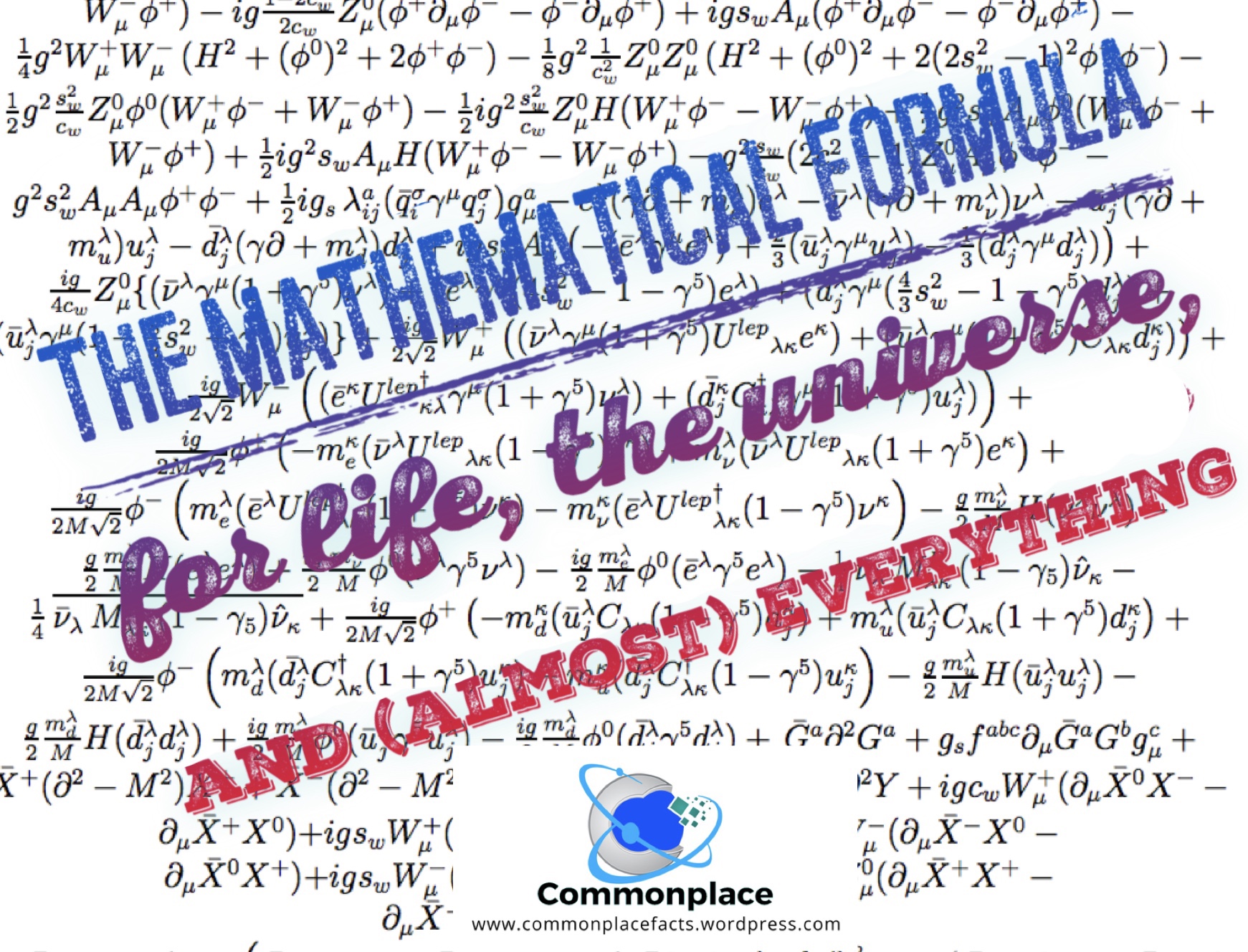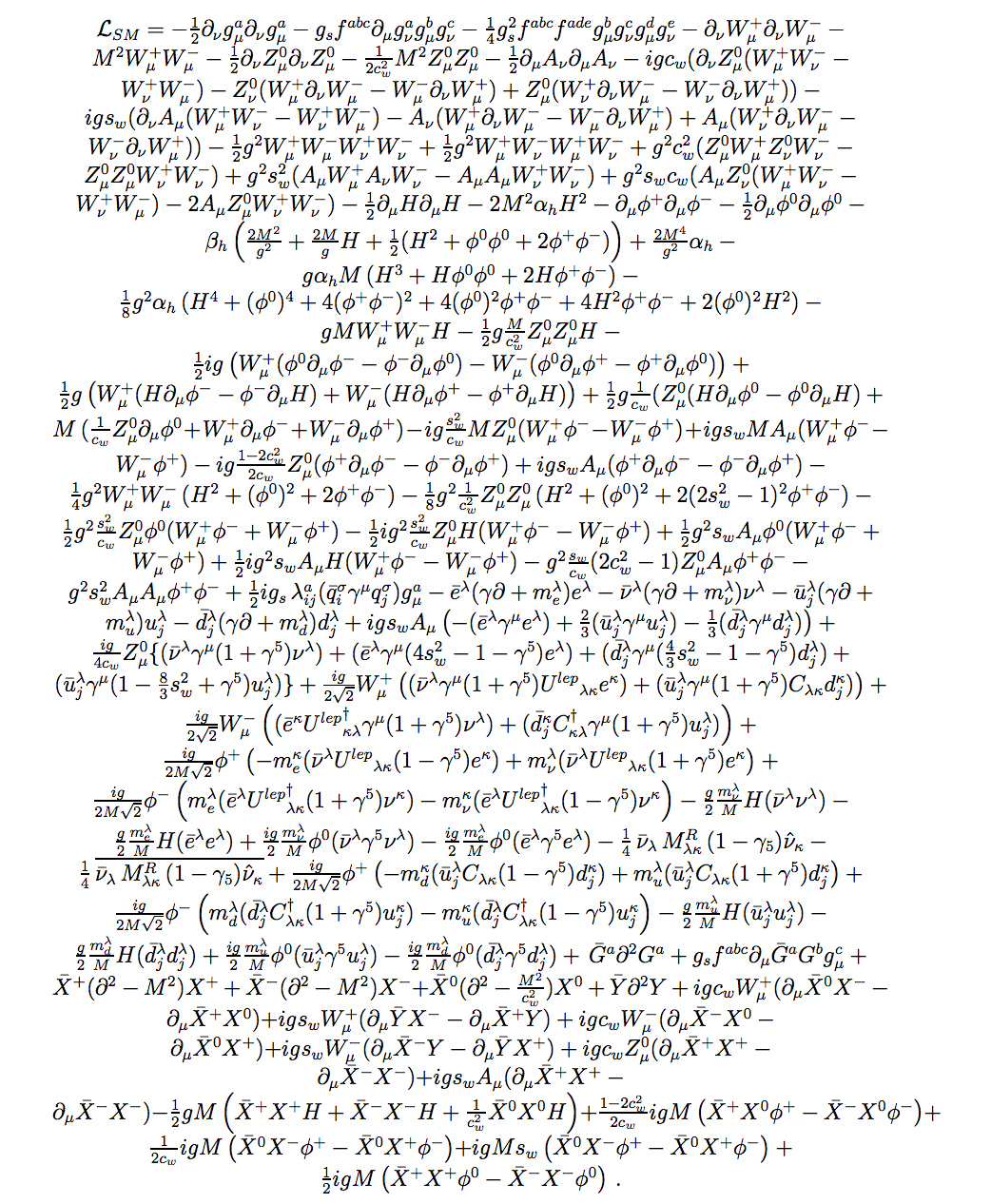
Readers of Douglas Adams‘ The Hitchhiker’s Guide to the Galaxy know the answer to life, the universe, and everything is 42. What they may not know is the mathematical formula that will (almost) explain life, the universe, and everything. That formula is the Standard Model, and it is as impressive in appearance as it is in function.
The Standard Model is an attempt to express all of the laws of physics and the maximum possible energy that can exist within the universe. It succeeds in tying together everything that we know except for one trivial detail: gravity. Physicists have yet to figure out how to successfully merge the bridge between the Newtonian universe, which is governed by the gravitational attraction between large objects, and the electronuclear realm, where gravity’s rules don’t seem to apply. While the Standard Model does well at incorporating Special Relativity, it does not include General Relativity and will fail at instances and distances where the graviton is expected to emerge.
The Standard Model can be expressed in a number of ways. Ironically, the gargantuan mathematical formula in Lagrangian form is said to be the simplest explanation:

While this may appear to be something recovered from the wreckage of an alien spacecraft in Roswell, all of the symbols have a purpose.
Section 1

These lines in the Standard Model are ultra-specific to the gluon, the boson that carries the strong force. Gluons come in eight types, interact among themselves and have what’s called a color charge.
Section 2

Almost half of this equation is dedicated to explaining interactions between bosons, particularly W and Z bosons.
Bosons are force-carrying particles, and there are four species of bosons that interact with other particles using three fundamental forces. Photons carry electromagnetism, gluons carry the strong force and W and Z bosons carry the weak force. The most recently discovered boson, the Higgs boson, is a bit different; its interactions appear in the next part of the equation.
Section 3

This part of the equation describes how elementary matter particles interact with the weak force. According to this formulation, matter particles come in three generations, each with different masses. The weak force helps massive matter particles decay into less massive matter particles.
This section also includes basic interactions with the Higgs field, from which some elementary particles receive their mass.
Intriguingly, this part of the equation makes an assumption that contradicts discoveries made by physicists in recent years. It incorrectly assumes that particles called neutrinos have no mass.
Section 4

In quantum mechanics, there is no single path or trajectory a particle can take, which means that sometimes redundancies appear in this type of mathematical formulation. To clean up these redundancies, theorists use virtual particles they call ghosts.
This part of the equation describes how matter particles interact with Higgs ghosts, virtual artifacts from the Higgs field.
Section 5

This last part of the equation includes more ghosts. These ones are called Faddeev-Popov ghosts, and they cancel out redundancies that occur in interactions through the weak force.
So there you have it. If you ever begin to despair and wonder what everything is all about, you just have to pull out this handy little formula, and you theoretically will have (almost) all the answers. If all else fails, you can revert to the Hitchhiker’s Guide to the Galaxy; it’s probably easier to understand.
Read more fun facts about physics.
Read more fun facts about mathematics.
As an Amazon Affiliate, Commonplace Fun Facts receives compensation for every qualified purchase from a linked Amazon product.
Categories: Astronomy and Space, Education, Mathematics, Measurements, Physics, Science

Quantum physics is like women, I always feel like I’m on the verge of understanding when in reality I’m just cluelessly referencing popular wisdom.
LikeLiked by 3 people
Ha! Thanks for the first big laugh of my day!
LikeLike
Don’t know why but this reminded me of Nicola Tesla. He once said ‘if you want to understand the world think in terms of energy, vibrations, and frequency’ and Quantum mechanics is very hard to comprehend. I was lost at Schrodinger’s equation…
LikeLiked by 1 person
Good observation. I was lost throughout the writing of the post. I pursued it because I was intrigued by the way the formula looked. I’d love to be able to memorize and just write it down during meetings to make it appear that I’m brilliant.
LikeLiked by 1 person
That requires skill….
I can’t seem to memorize formulas unless I know the significance of each and everything. I gave up after taking biophysical chemistry!
LikeLiked by 1 person
Don’t panic!
Space is big. You just won’t believe how vastly, hugely, mind-bogglingly big it is. I mean, you may think it’s a long way down the road to the chemist’s, but that’s just peanuts to space.
Deep Thought! The Universal porn flick!
LikeLiked by 1 person
There’s not a lot in the realm of human experience that can’t be addressed through a Douglas Adams’ quote.
LikeLike